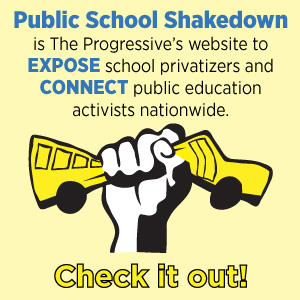Public school reform seems to boil down to closing schools; sending students to higher-achieving schools; converting a “failing” school to a charter school; replacing the principal, reforming instruction, and increasing learning time; and giving teachers monetary incentives to do better. Such “reform” seems as off the mark and ineffective as placing a Band-Aid on a melanoma. So the question that needs to be asked is what would real reform look like?
As a society, we, the “village” that it takes to raise a child, need to make a conscious commitment to ensuring that all children receive a free and high-quality public education. Without such a commitment, and without that education, our children will not be able to differentiate between sound bites, propaganda, demagogy, and the facts of a situation or position. Without an educated citizenry, our very governance by informed consent is in jeopardy, not to mention the assurance of future generations prepared for parenthood, employment, and creative efforts that enrich us all.
We need to determine how much it actually costs to educate a child for a year of schooling, including programs that children require in order to learn to their potential.
We need to create a system of funding for this education that is not compromised by the ebbs and flows of the economy or by political whims. This would mean the creation of a payment system whereby all members of the “village” share equally in the effort to have children receive a public education. A sales tax of 1 percent on all nonessential goods and services is one example of such an approach.
We need to have the federal government pay for any program it mandates states to follow. This includes the money to develop, implement, and maintain such a program.
We need a system of oversight to ensure that revenues for education are received and properly allocated for what they are intended. This could be done through an independent agency created for this purpose.
We need to view our children as the unique and special people that they are. Our schools need to become the “neighborhoods,” to use the late Fred Rogers’ term, that create the means for each child’s uniqueness and potential to be realized.
One qualification for anyone who works in schools should be a love and respect for children. Anyone lacking in these two areas should be asked to seek employment elsewhere.
We need to approach each child as a whole person, as someone who has physical, emotional, social, intellectual, artistic, and spiritual needs. Children are more than just brains to be filled and candidates for the job market.
We need to realize that not all children are developmentally ready for learning basic skills at the same time, nor do they learn in the same way. Moreover, they cannot show what they have learned by using only one means for measuring learning success.
We need to do away with a graded K-3 system. Instead, we need to provide for an ungraded learning environment during these four critical years of discovery and basic-skills development. We need to focus on meeting the needs of each child, so that at the end of this time, all children will be ready to go from “learning to read” to “reading to learn,” and will have become proficient in all areas of basic-skills development.
Each child in the primary and elementary grades requires a needs assessment at the beginning of the school year. Each needs to be provided with an individualized learning program. This would be closely monitored and, at year’s end, evaluated to determine how well the teacher and the child did in meeting the goals and objectives initially established. This could be part of the teacher’s evaluation process.
Each school site reflects the community within which it is placed, and each needs to perform a needs assessment to determine how best to provide for its students. Part of this assessment should determine the impact that poverty, abuse, gangs, violence, family transience, and lack of parent support have on children’s learning and well-being.
“Professional educators need to be allowed to do what they know works for children.”
We need to focus on the development of the neighborhood school as an essential child- and family-support center within a community.
Instead of charter schools, neighborhood schools need to become the learning laboratories that provide modeling for best educational practice.
All children need to be able to understand, speak, read, and write classroom English to ensure equal opportunities for employment and to participate as informed citizens.
We need to reintroduce the teaching of civics in middle and high school, and implement a test on the U.S. Constitution that students would have to pass in order to graduate from high school.
We need to have those who are professionals in curriculum, pedagogy, school psychology, speech and language pathology, public health, educational finance, administration, and education research determine educational policy, instead of think tanks, special-interest groups, and politicians. Professional educators need to be allowed to do what they know works for children.
Within each district, we must create a consensus-building approach to problem-solving that embraces input from all sectors of the school community before the creation or implementation of any education policy.
There needs to be a conscious process of thinking through the consequences of any policy before it is implemented.
Our philosophy of education needs to be predicated on what we know works and not on the currently favored education funding fad.
Our training programs need to be based on a professional-school model for those who teach primary grades. This approach would require three years of “apprenticeship” with master teachers, as a part of a five-year credentialing program.
This professional-school model needs to be centered on current research in pedagogy and classroom management, so that graduates are taught the latest information available on the thinking in the field. Preparation programs also need to provide practitioners with a thorough grounding in educational history, so that they can learn from the successes and failures of the past.
Moreover, training programs need to weed out those credential candidates who are emotionally, temperamentally, or intellectually unsuited to work with children.
District administrators need to exercise responsibility in evaluating professional staff members. A probationary teacher should be evaluated each of his or her probationary years. If any issue presents itself during this time, steps should be taken to help the teacher to improve. If he or she is unable or unwilling to improve, termination should follow.
We need to make in-service training a priority. A minimum of 50 hours per area of focus per year should be required. And this should apply to all personnel: classroom, support-services, clerical, and service workers. The emphasis should be on best practices in all staffing areas.
New-hire and probationary classroom and support-services staff need to have hands-on mentoring for the first two years on the job.
We need to view the role of unions as a necessary check and balance, protecting staff members from managerial abuse and ensuring due-process rights.
Most of all, we need to stop the process of scapegoating and disparaging members of the education community. Negativity breeds negativity and creates the destructive impact of unnecessary stress on those who work with children. Acknowledgment and support breeds the development of team work and the heightened potential for success.








